1. Introduction
In the previous tutorial, we explored the biological species concept, and the barriers that keep closely related species apart. Now we’ll turn our focus to speciation: the process by which new species arise.
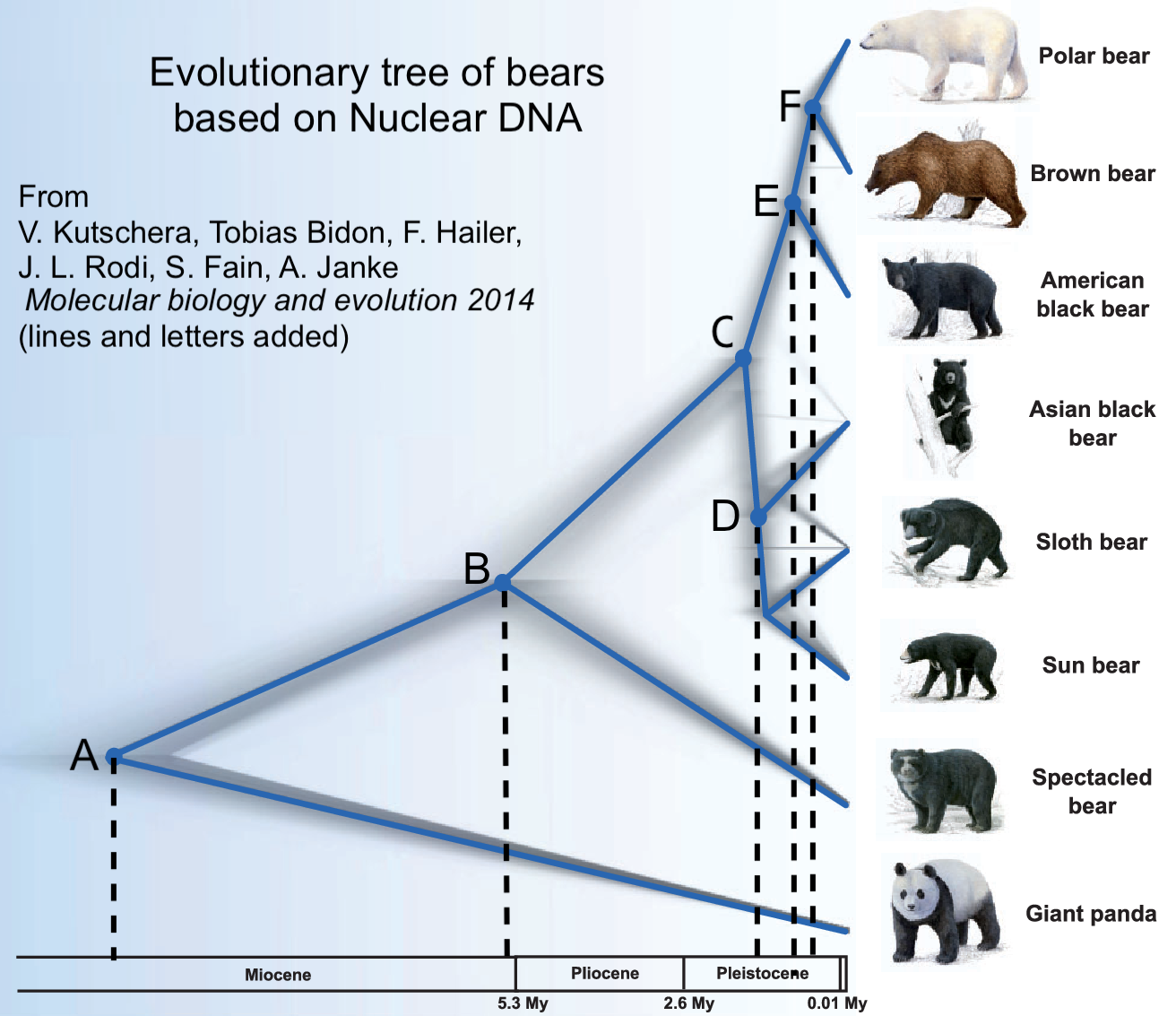 Before seeing how speciation happens, let’s clarify what we mean by “the process by which new species arise.” The image on the left shows the evolutionary history of bears. It’s based on the analysis of DNA.
Before seeing how speciation happens, let’s clarify what we mean by “the process by which new species arise.” The image on the left shows the evolutionary history of bears. It’s based on the analysis of DNA.
This image represents the following idea: if you went back in time to point “A”, about 12 million years ago, you wouldn’t find the 8 species of bears that exist today. Rather, you’d find one bear species that was the ancestor of all currently existing bears. This ancestral bear species split apart into two lineages. One line led to Panda bears. The other line gave rise to all other bears. In other words, that one ancestral species split apart into two descendant species. How?
You can repeat that question for any branch point on the diagram. Find point “B.” At about 5.3 million years, that line of bears split again, one branch leading to the Spectacled bear (the only bear found in South America), the other branch leading to all other bears (except the Panda). How? Or, to choose the most recent example, how did polar bears and brown bears — which share a common ancestor about 250,000 years ago split apart?
So that’s the question we’re trying to answer: How does one ancestral species split into two?
2. Interactive Reading: Allopatric Speciation
One mechanism of speciation is called allopatric speciation. We’ll start with a case study.
[qwiz style=”width: 650px !important; min-height: 400px !important;” qrecord_id=”sciencemusicvideosMeister1961-Allopatric speciation (Int. Read., HS)”]
[h] Speciation Interactive Reading
[q] Until about 2.8 million years ago, there was a gap between the southern tip of North America and the northern tip of South America. This gap allowed water to flow from the Pacific Ocean to the Atlantic Ocean, and vice versa. But then, the movement of the continents created a land bridge between the two continents: the Isthmus of Panama (shown below).
[q] Today, two closely related species of shrimp are found on each side of the Isthmus. One is on the Atlantic side, and one is on the Pacific side. Under natural conditions, they have no contact. But when they’re experimentally brought together, these two species don’t interbreed. Instead, they aggressively snap their claws at one another. (source: Biology, Starr, Taggart, Evers, Starr, 14th ed.)
In your student learning guide, use what you’ve learned about species, reproductive barriers, natural selection, and population genetics, to write a short explanation of what’s going on. This is just a preliminary idea, so speculate!
Click “Continue” when you’re ready.
[q]
The image on the left shows a model for explaining what you encountered on the previous card. It’s called allopatric speciation. The “allo” prefix means “other” or “another.” The “patric” stem means “country” (a stem that also appears in words like patriotic).
Take a moment and see if you can think through an explanation of what happened in the isthmus of Panama, using this model. Go ahead and give it a try, preferably by talking it through with a partner (or even saying it out loud to yourself). Click “Continue” when you’re ready.
[q labels = “top”]Now let’s look at this model, step by step.
| In stage one there’s only one __________ with two subpopulations. What maintains the sub-populations as part of a single species is the free flow of _________ from one population to the other.
In stage two, a _________ disrupts gene flow. In each subpopulation, processes like ___________ lead distinct variants to arise. Thinking about this in terms of population genetics, you might say that ________ frequencies are starting to differ between these two subpopulations. |
[l]allele
[f*] Great!
[fx] No, that’s not correct. Please try again.
[l]barrier
[f*] Good!
[fx] No. Please try again.
[l]genes
[f*] Excellent!
[fx] No. Please try again.
[l]mutation
[f*] Correct!
[fx] No, that’s not correct. Please try again.
[l]species
[f*] Excellent!
[fx] No. Please try again.
[q labels = “top”]
| Imagine that in stage three, the environment on each side of the barrier has changed. Now, each population will be subject to different __________ pressures. This can lead to further _________________ between each subpopulation’s ________ pool
In stage four, the geographic barrier has been __________. This can involve a _______ drying up, or a mountain range _________ away. When the two populations encounter each other again, they’ve evolved into two distinct ________ that are ________________ isolated from one another, and which can no longer _____________. |
[l]differentiation
[f*] Great!
[fx] No, that’s not correct. Please try again.
[l]eroding
[f*] Great!
[fx] No, that’s not correct. Please try again.
[l]gene
[f*] Correct!
[fx] No. Please try again.
[l]interbreed
[f*] Good!
[fx] No. Please try again.
[l]removed
[f*] Correct!
[fx] No. Please try again.
[l]reproductively
[f*] Correct!
[fx] No, that’s not correct. Please try again.
[l]river
[f*] Good!
[fx] No. Please try again.
[l]selective
[f*] Excellent!
[fx] No, that’s not correct. Please try again.
[l]species
[f*] Good!
[fx] No, that’s not correct. Please try again.
[q labels = “top”]
Here’s a quick summary of the allopatric model of speciation: ________________ isolation leads to ____________ differentiation, which results in _______________ isolation.
[l]genetic
[f*] Good!
[fx] No, that’s not correct. Please try again.
[l]geographical
[f*] Good!
[fx] No, that’s not correct. Please try again.
[l]reproductive
[f*] Great!
[fx] No. Please try again.
[q] Here’s the same image that started this interactive reading. If you’re understanding allopatric speciation, you should be able to write a short paragraph explaining the speciation of shrimp that followed the formation of the isthmus of Panama. Give it a try, and then compare your answer to mine.
[c]IFNob3cgdGhl IGFuc3dlcg==[Qq]
[f]IE9yaWdpbmFsbHksIHRoZSB0d28gc3BlY2llcyBvZiBzaHJpbXAgd2VyZSBvbmUgc3BlY2llcywgY29ubmVjdGVkIGJ5IGdlbmUgZmxvdy4gV2hlbiB0aGUgaXN0aG11cyBmb3JtZWQsIGdlbmUgZmxvdyB3YXMgbm8gbG9uZ2VyIHBvc3NpYmxlLiBSYW5kb20gbXV0YXRpb24sIGFsb25nIHdpdGggZGlmZmVyZW50IHNlbGVjdGl2ZSBwcmVzc3VyZXMgb24gZWFjaCBzaWRlIG9mIHRoZSBpc3RobXVzLCBsZWQgdGhlIEF0bGFudGljIGFuZCBQYWNpZmljIHBvcHVsYXRpb25zIHRvIGRpZmZlcmVudGlhdGUuIE5vdywgd2hlbiB0aGV5JiM4MjE3O3JlIHBsYWNlZCB0b2dldGhlciwgdGhleSBjYW4gbm8gbG9uZ2VyIGludGVyYnJlZWQuIEluIG90aGVyIHdvcmRzLCB0aGUgaW5pdGlhbCBnZW9ncmFwaGljIGlzb2xhdGlvbiBsZWQgdG8gZ2VuZXRpYyBkaWZmZXJlbnRpYXRpb24gdGhhdCByZXN1bHRlZCBpbiByZXByb2R1Y3RpdmUgaXNvbGF0aW9uLiBPbmUgc3BlY2llcyBoYXMgZXZvbHZlZCBpbnRvIHR3by4=[Qq]
[/qwiz]
3. Speciation Happens More Easily in Small, Peripheral Populations
One of the great biologists of the last century, Ernst Mayr, suggested that allopatric speciation would be accelerated in small, isolated populations found on the edge of the parent species’ geographical range.
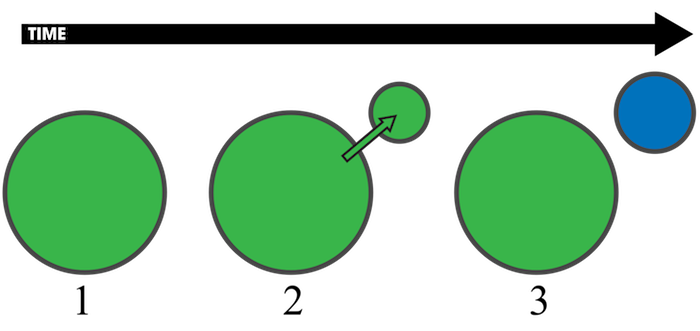
The diagram to your left shows this in a very schematic way. At time “1,” there’s one original parent population. At time “2,” a small sub-population has been established (the smaller circle on the top right). Because of distance or geography, that small population becomes cut off from its parent population.
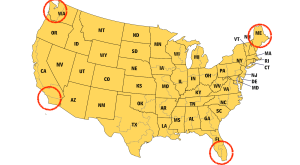
Over time, the small sub-population at “2” will start to become genetically and phenotypically different from the main population. Differences will arise for two reasons. First, genetic drift is accelerated in small populations. Second, the conditions on the edge might lead to more intense natural selection. That’s because at the edge environmental and biological conditions might be somewhat different from what’s experienced by the rest of the population.
Over time, the small isolated population will differentiate until it can no longer interbreed with its parent population. Byperiodd 3, the isolated population in the top right has evolved into a new species. One species has become two.
4. Hybrid Zones
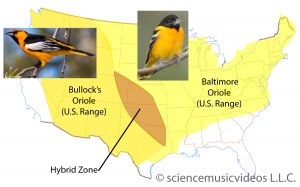 Sometimes, two closely-related species share a hybrid zone. That’s an area between two species where members of the two species can interbreed with another species. However, even though hybrids emerge in this in-between area, there’s not enough gene flow to cause the two species to merge into one.
Sometimes, two closely-related species share a hybrid zone. That’s an area between two species where members of the two species can interbreed with another species. However, even though hybrids emerge in this in-between area, there’s not enough gene flow to cause the two species to merge into one.
You can see this in the image to your left with North American Orioles. There are two species, one in eastern North America (the Baltimore Oriole), and one in western North America (Bullock’s Oriole). In the central part of the United States (states such as Texas, Oklahoma, Kansas, and Colorado), these two closely-related species form fertile hybrids.
Click through the rest of these images to see more examples, and then answer the questions.
[qwiz summary=”true” qrecord_id=”sciencemusicvideosMeister1961-Hybrid Zones (HS)”]
[h] Understanding Hybrid Zones
[i]
[q] Hybrid Zone: Swallowtail Butterflies
[q] Hybrid Zone: Redstarts, South America
[q] Hybrid Zone: European Crows and Magpies
[q labels = “top”]How are these hybrid zones to be understood? They show ______________ in process. The related species that can still ____________ split apart relatively ______________. So, in areas where the range of each new species overlaps, reproductive isolation is _______________.
[l]hybridize
[f*] Great!
[fx] No, that’s not correct. Please try again.
[l]incomplete
[f*] Good!
[fx] No. Please try again.
[l]recently
[f*] Great!
[fx] No, that’s not correct. Please try again.
[l]speciation
[f*] Great!
[fx] No. Please try again.
[q] In the series of diagrams below, which number shows a hybrid zone?
[textentry single_char=”true”]
[c]ID M=[Qq]
[f]IE5pY2UhICYjODIyMDszJiM4MjIxOyBzaG93cyBhIGh5YnJpZCB6b25lLg==[Qq]
[c]IEVudGVyIHdvcmQ=[Qq]
[c]ICo=[Qq]
[f]IE5vLiBIZXJlJiM4MjE3O3MgYSBoaW50LiBMb29rIGZvciB0aGUgbnVtYmVyIHdoZXJlIHR3byBkaXN0aW5jdCBzcGVjaWVzIGFyZSByZXByZXNlbnRlZCAodGhyb3VnaCB0d28gZGlzdGluY3QgY29sb3JzKS4gQnV0IHRoZXJlIGFsc28gbmVlZHMgdG8gYmUgYSB6b25lIHdoZXJlIHRoZSB0d28gYmxlbmQgdG9nZXRoZXIu[Qq]
[q] In the series of diagrams below, number 4 shows complete [hangman]. In number 3, there’s a [hangman] zone in which limited [hangman] flow can occur between the species represented by the blue and green colors.
[c]c3BlY2lhdGlvbg==[Qq]
[c]aHlicmlk[Qq]
[c]Z2VuZQ==[Qq]
[/qwiz]
5. Clines and Ring Species
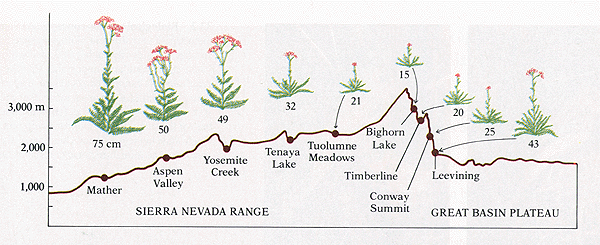 The diagram to your left shows how the height of a plant called yarrow varies on a West to East axis across the Sierra Nevada mountains in California.
The diagram to your left shows how the height of a plant called yarrow varies on a West to East axis across the Sierra Nevada mountains in California.
Why does the height vary? What you’re seeing is natural selection at work. Mather is just above sea level (35 meters). Tuolumne meadows is 2600 meters. The growing season is much shorter in Tuolumne meadows, so the yarrow there has been selected to grow just tall enough to produce flowers, get pollinated, and pass its genes on to the next generation. At Mather, there’s a much longer growing season. There’s selection for growing taller to outcompete other yarrow plants (and plants of other species).
Theheight differencet was caused by natural selection in different environments. Now it’s encoded in the genes of the plants found at these various locations. This has been proved by experiments at Stanford University. Seeds from Mather were grown in a garden at Stanford, which is at sea level. They grew to be 75 cm tall. Seeds from Tuolumne meadows were planted in the same garden under the same conditions. They grew to be 21 cm tall. The differences between the plants growing in these locations, in other words, are genetic.
Genetic variation across a geographic axis is called a cline. Within a cline, there’s genetic variation, but gene flow is possible along the entire spread of the species. In other words, the plants from Mather can easily cross-pollinate with plants from their neighbors in Aspen Valley. The ones in Aspen Valley could interbreed with those from Yosemite creek.
But as the subpopulations get further and further from one another, the genetic differences accumulate. Would a plant from Mather be able to cross-pollinate with a plant from Leevining? Switching to the diagram below might make this a bit easier to visualize. In a cline, any two adjacent populations are similar enough to successfully interbreed. After all, they’re all members of the same species.

In nature, the only way that genes can flow is between adjacent populations (A and B, B and C, etc.) But what about the populations on the two extreme edges? In nature, these populations never meet. But individuals from population “A” might evolve to be so different from those in population “E” that if they were experimentally brought together, they might not be able to interbreed.
In nature, this experiment has occurred…It’s called a ring species.
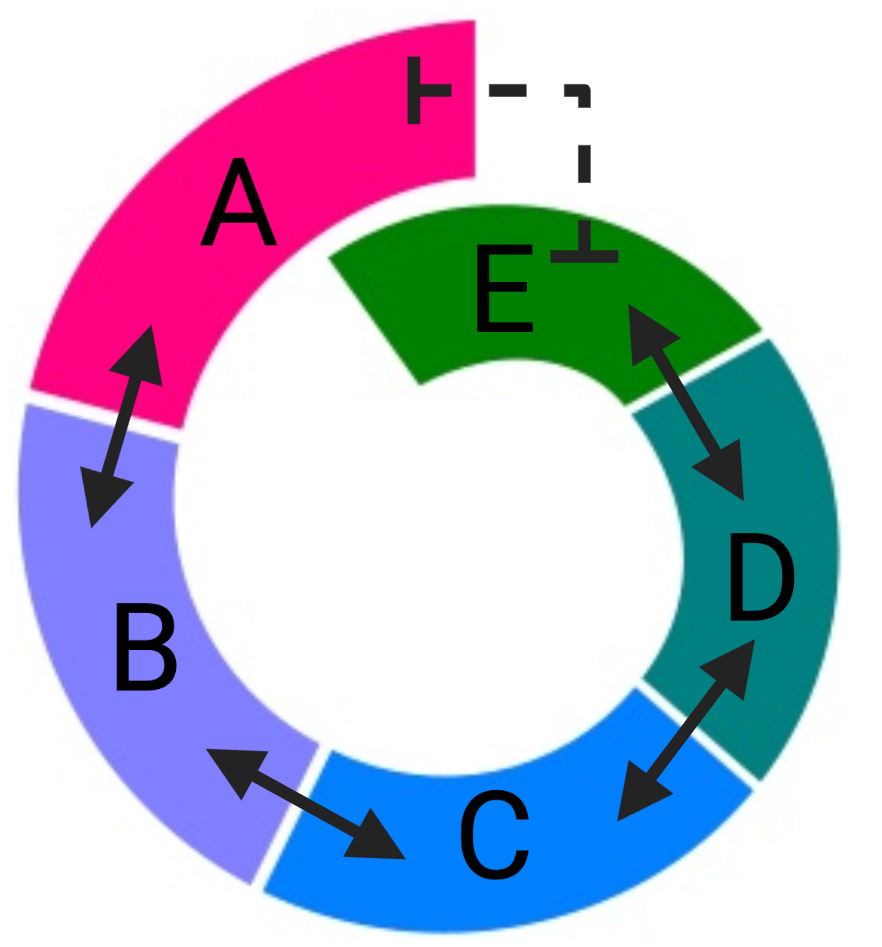
Again, any of the two adjacent populations can successfully interbreed. But population E has become so genetically differentiated from population A that even though their ranges overlap, no interbreeding is possible.
Read below for a case study.
[qwiz qrecord_id=”sciencemusicvideosMeister1961-Ring Species (Int. Read., HS)”]
[h]Ring Species: interactive reading
[i]
[q]
Ensatina eschscholtzii is species of salamander whose range extends from Baja California (in Mexico) up to British Columbia (in Canada). Across its geographic range, E. eschscholtzii has diversified into several subspecies (numbered 1 through 7). While each subspecies can interbreed with the neighboring population (subspecies 1 can breed with 2, 2 with 3, and so on, no interbreeding is possible between subspecies 1 and subspecies 7.
Note that the one place where Ensatina salamanders can’t live is in California’s Central Valley, which is much hotter and drier than either the California coast ranges, the Sierra Nevada mountains, or the mountains of Oregon, Washington, and British Columbia.
Based on what you know about speciation, see if you can explain what’s going on. Click Continuee” when you’re ready.
[q labels = “top”]
Ring species can be thought of as a species with_________ variation that, for geographical reasons, has curled back upon itself. Diagram A at left represents a species that’s spread over a geographic range. While ________ are flowing between each adjacent population, there’d be significant differences in phenotypes and allele_____________ between populations 1 and 5. In fact, it’s possible that if individuals from populations 1 and 5 were experimentally removed from wherever they lived and placed in contact, they might have difficulty _________________.
[l]interbreeding
[fx] No, that’s not correct. Please try again.
[f*] Excellent!
[l]clinal
[fx] No, that’s not correct. Please try again.
[f*] Excellent!
[l]frequencies
[fx] No, that’s not correct. Please try again.
[f*] Great!
[l]genes
[fx] No. Please try again.
[f*] Good!
[q]
As Ensatina salamanders evolved, they spread from one area to the next, perhaps moving up the California coast, then across the mountains of northern California, then down the Sierras. But where the ring curled back upon itself, there was so much _________________ that ________________ between subspecies 1 (E. eschscholtzii eschscholtzii) and subspecies 7 (E. eschscholtzii klauberi) had become _____________. It’s almost as if these two subspecies could be almost be considered to be different _____________…if not for the _____________ between all the intermediate _____________.
[l]differentiation
[fx] No. Please try again.
[f*] Correct!
[l]gene flow
[fx] No, that’s not correct. Please try again.
[f*] Good!
[l]impossible
[fx] No, that’s not correct. Please try again.
[f*] Great!
[l]interbreeding
[fx] No. Please try again.
[f*] Great!
[l]subspecies
[fx] No, that’s not correct. Please try again.
[f*] Excellent!
[l]species
[fx] No, that’s not correct. Please try again.
[f*] Correct!
[/qwiz]
6. Allopatric Speciation: Checking Understanding
The big idea of this tutorial has been allopatric speciation: speciation that’s related to geographic barriers. In the next tutorial, we’ll learn about another mode of speciation: one that can occur without geographic barriers. But before taking that on, complete the quiz below.
[qwiz qrecord_id=”sciencemusicvideosMeister1961-Allopatric Speciation Checking Understanding (HS)”] [h]
Allopatric Speciation: Checking Understanding
[i]
[q] Speciation that involves a geographical barrier is called [hangman] speciation.
[c]IGFsbG9wYXRyaWM=[Qq]
[f]IEV4Y2VsbGVudCE=[Qq]
[q] In the diagram below, which phase shows when a geographic barrier first subdivides a population into two isolated gene pool?.
[textentry single_char=”true”]
[c]ID I=[Qq]
[f]IEV4Y2VsbGVudC4gJiM4MjIwOzImIzgyMjE7IHNob3dzIGEgZ2VvZ3JhcGhpYyBiYXJyaWVyIHN1YmRpdmlkaW5nIHRoaXMgcG9wdWxhdGlvbiBpbnRvIHR3byBnZW5lIHBvb2xzLg==[Qq]
[c]IEVudGVyIHdvcmQ=[Qq]
[c]ICo=[Qq]
[f]IE5vLiBKdXN0IGxvb2sgZm9yIHRoZSBlYXJsaWVzdCBtb21lbnQgaW4gdGhpcyBzZXF1ZW5jZSB3aGVuIGFsbGVsZXMgd291bGQgbm8gbG9uZ2VyIGJlIGFibGUgdG8gZmxvdyBmcm9tIHRoZSBsZWZ0IHNpZGUgb2YgdGhlIGNpcmNsZSB0byB0aGUgcmlnaHQgc2lkZS4=[Qq]
[q]In the diagram below, which letter or number represents gene flow?
[textentry single_char=”true”]
[c]IG E=[Qq]
[f]IE5pY2Ugam9iLiBMZXR0ZXIgJiM4MjIwO2EmIzgyMjE7IHJlcHJlc2VudHMgZ2VuZSBmbG93Lg==[Qq]
[c]IEVudGVyIHdvcmQ=[Qq]
[c]ICo=[Qq]
[f]IE5vLiBHZW5lIGZsb3cgaXMgYSBwcm9jZXNzIHRoYXQgbW92ZXMgYWxsZWxlcyBiZXR3ZWVuIHBvcHVsYXRpb25zLCBwcmV2ZW50aW5nIGRpZmZlcmVudGlhdGlvbi4=[Qq]
[q]By stage 4, the two species can no longer [hangman] \.
[c]IEludGVy YnJlZWQ=[Qq]
[q]The basic idea of allopatric speciation is that ______________ isolation leads to genetic differentiation, which leads to reproductive isolation.
[hangman ]
[c]IGdlb2dyYX BoaWNhbA==[Qq]
[q]The basic idea of allopatric speciation is that geographical isolation leads to genetic differentiation, which leads to ___________ isolation.
[hangman ]
[c]IHJlcHJvZH VjdGl2ZQ==[Qq]
[q labels = “top”]
In the speciation model shown at left, the __________ size of the peripheral population allows for higher amounts of ________________. However, _____________ won’t occur until ______________ is cut off. By stage 3, the two populations are reproductively ____________ from one anothe .
[l]genetic drift
[fx] No, that’s not correct. Please try again.
[f*] Great!
[l]gene flow
[fx] No, that’s not correct. Please try again.
[f*] Good!
[l]isolated
[fx] No. Please try again.
[f*] Great!
[l]small
[fx] No, that’s not correct. Please try again.
[f*] Correct!
[l]speciation
[fx] No, that’s not correct. Please try again.
[f*] Great!
[q]A [hangman] is a gradual shift in genetic variation that occurs along a geographical axis.
[c]IGNs aW5l[Qq]
[q]A cline is a gradual shift in genetic [hangman ] that occurs along a geographical axis.
[c]IHZhcmlh dGlvbg==[Qq]
[q]Number 3 below represents a [hangman] zone.
[c]aHli cmlk[Qq]
[q]In the speciation model below, the gradual shift between green and blue in diagram 2 is called a [hangman].
[c]Y2xp bmU=[Qq]
[q]The complex of E. eschscholtzii subspecies shown belo is called a [hangman] species.
[c]cmlu Zw==[Qq]
[q]A key characteristic of the E. eschscholtzii subspecies complex shown below is the inability of subspecies 1 and subspecies 7 to [hangman].
[c]aW50ZXJi cmVlZA==[Qq]
[q]In the E. eschscholtzii ring species complex shown below, if it weren’t for the gene flow between all of the adjacent subspecies, you could almost think of subspecies 1 and 7 as separate [hangman].
[c]c3BlY2 llcw==[Qq]
[q]In the diagram below, which letter represents a geographical barrier
[textentry single_char=”true”]
[c]WA ==[Qq]
[f]IE5pY2Ugam9iLiBMZXR0ZXIgJiM4MjIwO3gmIzgyMjE7IHJlcHJlc2VudHMgZ2VuZSBmbG93Lg==[Qq]
[c]IEVudGVyIHdvcmQ=[Qq]
[c]ICo=[Qq]
[f]IE5vLiBGaW5kIHdoYXQmIzgyMTc7cyBzZXBhcmF0aW5nIHRoZSBwb3B1bGF0aW9uIG9uIHRoZSBsZWZ0IGZyb20gdGhlIHBvcHVsYXRpb24gb24gdGhlIHJpZ2h0Lg==[Qq]
[q]In the diagram below, which letter represents the moment in which mutations start to emerge in the gene pools of each subpopulation?
[textentry single_char=”true”]
[c]Qw ==[Qq]
[f]IFRlcnJpZmljLiBMZXR0ZXIgJiM4MjIwO0MmIzgyMjE7IHJlcHJlc2VudHMgdGhlIG1vbWVudCB3aGVyZSBtdXRhdGlvbnMgc3RhcnQgdG8gZW1lcmdlIGluIGVhY2ggc3ViLXBvcHVsYXRpb24=[Qq]
[c]IEVudGVyIHdvcmQ=[Qq]
[c]ICo=[Qq]
[f]IE5vLiBGaW5kIHRoZSBtb21lbnQgd2hlbiB0aGUgdHdvIHNlcGFyYXRlZCBwb3B1bGF0aW9ucyBzdGFydCB0byBiZSBkaWZmZXJlbnQu[Qq]
[q]If the environments experienced by the populations on the left and right sides are different, then another force causing the populations to genetically differentiate would be [hangman] [hangman].
[c]bmF0dXJhbA==[Qq]
[c]c2VsZWN0aW9u[Qq]
[q]In the diagram below, which letter represents the moment in which the two new species have become reproductively isolated?
[textentry single_char=”true”]
[c]Rg ==[Qq]
[f]IFRlcnJpZmljLiBMZXR0ZXIgJiM4MjIwO0YmIzgyMjE7IHJlcHJlc2VudHMgdGhlIG1vbWVudCB3aGVuIHRoZSB0d28gcG9wdWxhdGlvbnMgYXJlIGJhY2sgaW4gY29udGFjdCwgYnV0IG5vIGxvbmdlciBpbnRlcmJyZWVkLiBUaGF0IG1lYW5zIHRoZXkmIzgyMTc7dmUgYmVjb21lIHJlcHJvZHVjdGl2ZWx5IGlzb2xhdGVkLg==[Qq]
[c]IEVudGVyIHdvcmQ=[Qq]
[c]ICo=[Qq]
[f]IE5vLiBGaW5kIHRoZSBtb21lbnQgd2hlbiB0aGUgdHdvIHBvcHVsYXRpb25zIGFyZSBiYWNrIGluIGNvbnRhY3QsIGJ1dCBtYWludGFpbmluZyB0aGVpciBkaXN0aW5jdGl2ZSBwaGVub3R5cGVzIChub3QgbWl4aW5nIHRvZ2V0aGVyKS4=[Qq]
[x][restart]
[/qwiz]
Links
- Sympatric Speciation (the next high school level tutorial in this module)
- Species and Speciation Menu (High School Level)
